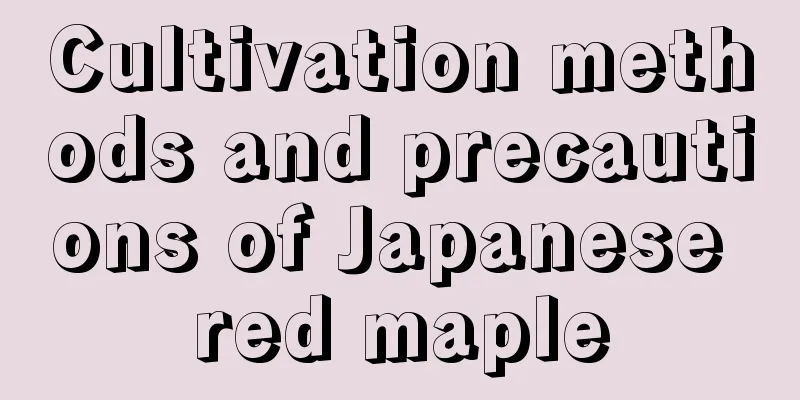Cultivation methods and precautions of Japanese red maple

1. Maintenance methods1. Soil: Japanese red maple is more suitable for growing in soil with good drainage. Loose soil is very beneficial to the breathing and growth of the roots. The soil prepared for it should be slightly acidic, and try not to use alkaline soil. 2. Watering: Try to water it according to the principle of watering when the soil is dry and watering when the soil is wet. It has a certain degree of drought resistance, so it doesn’t matter if you water it less at normal times, but it is best not to let water accumulate in the pot. 3. Sunlight: Give it sufficient light during normal maintenance. Under good light conditions, the color of its leaves will be brighter. If it is noon in summer, it is best to give it appropriate shade to avoid direct sunlight on the leaves. 4. Temperature: The most suitable temperature for its growth is around 20℃, and it has a certain degree of cold resistance. However, when winter comes, it is best to move it indoors for maintenance, and the temperature must be kept at least above 0℃ so that it can survive the winter safely. 2. Breeding techniques1. Pruning: Pruning is required during its growth period. The main purpose of pruning is to remove diseased branches and dead branches to avoid infection of other branches and make the plant healthier. Secondly, it can have a better plant shape and improve its ornamental value. 2. Planting: When first planting, you need to spray water from time to time to keep it moist. It also needs to be kept in a semi-shaded location for a few days, and only after the leaves grow can it be grown in the sun. After all its leaves are unfolded, it is necessary to apply diluted (nitrogen) liquid fertilizer. 3. Problem diagnosis and treatment1. Powdery mildew: Various problems are inevitable during maintenance, among which powdery mildew is the most common. This disease is usually the result of maintenance in a location with poor ventilation, and requires timely use of drugs for prevention and control. 2. Pests: The most common ones are scale insects, heart borers, aphids, etc. If they are discovered in time, you can use a toothbrush to brush off the eggs. If the problem is serious when you find it, you will need to use pesticides to spray. IV. Other issues1. Can it be grown indoors: Japanese red maple can be grown indoors, and it needs to be kept in a location with good lighting conditions during its growing period. When the summer sun is scorching, you need to temporarily move to a cool location. 2. Is it poisonous? Japanese red maple is non-toxic. It is highly ornamental and has very bright leaves. It is very suitable for home planting and can be used as decoration in the living room. |
<<: Cultivation methods and precautions of Japanese begonia
>>: Cultivation methods and precautions of Shatian pomelo
Recommend
What to do if the leaves of the pteris fern turn yellow
Reasons why fern leaves turn yellow Too dry There...
What does Gesang flower mean?
1. Pursue happiness and good fortune In Tibet, Ge...
Can the fruit of the elmleaf plum be eaten?
Fruits of Prunus armeniaca Are the fruits of the ...
What are the effects of Phalaenopsis? Does Phalaenopsis have a fragrance?
1. Effects and efficacy 1. Home decoration: Phala...
How to trim golden grass
When is the right time to mow golden grass? The m...
The leaves of the lucky tree turn yellow and fall off. Here is a little trick to make it green immediately!
1. Too much water or too compacted soil reason: M...
Can honeycomb coal be used as flower soil?
Can honeycomb coal be used as flower soil? Honeyc...
What to do when cherry blossoms drop leaves
Cherry blossoms dropping leaves is a seasonal cha...
How to grow jade plants on the balcony and what should you pay attention to
1. Can it be grown on the balcony? It is relative...
How to pollinate potted lemons
Physiological structure Generally speaking, lemon...
Why do the leaves of the money tree turn yellow?
1. Causes of yellowing 1. Direct sunlight: Althou...
How to propagate the money tree by cuttings?
The fortune tree has a good meaning. Many people ...
How does Zixuanyue spend the winter?
temperature The best growing conditions for Purpl...
How to grow flat bamboo orchid
1. Breeding environment 1. Light: The native plac...
How to plant lily seeds
1. Planting time Lilies like to grow in an enviro...









